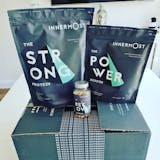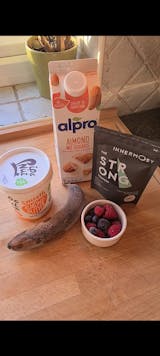Calling all yoga newbies!
We can all claim the fact that the past few years have not been an easy ride. With the world constantly throwing out new challenges for us to deal with (yeah that’s you COVID), and our stress levels rising as a result of this, there has never been a better time than the present to embark on your very own yoga journey.
Now, you may be questioning – ‘but I’m not flexible?’ and ‘there’s no way I can lift my legs above my head?’. However, yoga is not just about stretching your body into difficult poses, but a combination of physical and mental exercises to calm both the mind and strengthen one’s core. We all need a bit of that right now.
Yoga is in fact steeped in tradition and on further inspection more complex, with the philosophy of yoga a massive topic that even us here at Innermost won’t be able to go fully into – just saving you reading pages on pages. For beginner’s yoga, it is always beneficial to know the basics, so instead we have enclosed a handy guide giving you all the necessary details to get started…let’s just take it one stretch at a time.
History Of Yoga
Yoga’s rich history is vast and complicated, with a timeframe dating back around 5,000 years ago. From religion, philosophy, and of course the form of exercise we know it as today, the origins are somewhat cloudy. However, it has been stated that the earliest signs of yoga are in fact from the Vedic Period around 1500-500 BCE. Instead of exercise, this was found as transcriptions in Vedic literature. The written poems and hymns were thought to have encouraged spiritual enlightenment through a broadening of the mind, body, and soul.
Travelling from this period, yoga adapted through the Pre-Classical, Classical, and Post-Classical periods until it reached the current Modern Period from 1900 onwards. Seeing the presence of yoga in the West wasn’t actually well-known until the late 1800’s. The two main reasons for its spread were due to both Monks and Gurus spreading their knowledge within their local communities which then went from mouth to mouth, and also through travellers to India hearing all about this fascinating state of mind. They subsequently travelled back to their homeland to spread their exciting findings. Yoga was and still is a hot topic.
Yoga Today
Bringing us all very much back to the present, yoga is practised throughout the globe – from professional classes hosted by an instructor to a solo session at home upon an exercise mat. Today, yoga centres around the ethos of living in harmony with the universe - a physical, mental and spiritual system that us humans can practice to get in touch with our senses and ourselves. The three main aspects are focused around asana (poses), breathing exercises and meditation. However, unknown to many, there are in fact eight limbs of practice:
- The Yamas – moral principles
- The Niyamas – personal conduct
- Asana – the physical exercises
- Pranayama – breathing exercises
- Pratyahara – control of the senses
- Dharana – one-pointed focus on meditation
- Dhyana – devotion
- Samadhai – union with a higher power
Within the most common arm of practice, the physical exercises (Asana), you'll find all sorts of styles:
- Alignment-focused Iyengar Yoga
- Sweaty Ashtanga Yoga
- Relaxing Restorative Yoga
- Cardiovascular Rocket Yoga
- Spiritual Kundalini Yoga
- Deep Yin Yoga
Within some styles, there’s huge variety based on who’s teaching. For instance, a Vinyasa class could be fast and led by pop music, or silent with deep holds and controlled movement. In short, your physical yoga practice can be as hard as you want it to be.
Whilst each of this will bring their own unique benefits, whichever you pick, throwing yourself headfirst into a steady yoga routine will have profound benefits on your system:
- Increases strength, flexibility, and physical fitness
- Decreases anxiety, pain and depression
- Grounds emotions
- Allows you to focus on the present instead of the past or future
- Lightens the weight on your shoulders, creating peace
- Allows time for appreciation
Knowing all this information is good and all – but the tricky component is knowing where to start. First and foremost, before yoga – you should always warm up!
Warming Up For Yoga
As for any sports and activities, we all know that allowing your body to warm up prior is important for both performance and injury prevention. Yoga is no exception here. You may be questioning that surely as yoga is composed of stretches it could be counter-intuitive to warm up first as you’ll be warming your body up as you go along. This is incorrect. A pre-yoga warm up is great for many reasons including heating up the body from within to increase blood and fluid circulation, loosening muscles and joints, as well as getting your body and mind fully prepped for a session. It allows you to focus on the task in hand.
If you are someone that attends a class, then your practitioner will lay the warm-up sequence for you. However, if you are embarking on this solo, then the general rule of thumb is that warming up should last for around 5 to 15 minutes until your skin is warm to the touch and your heartbeat is elevated. Some of our best yoga warm-ups include the palm tree pose, pelvic tilt, planks, and leg stretches.
What Kit Will You Need For Yoga?
So, you have decided to finally take the plunge and have either joined a local class or have cleared some space within your own four walls to practice yoga at home - but what kit will you need? For many, this may conjure up an expensive shopping spree of picking out patterned leggings and tops, large drinks bottle as big as your head, and a fancy roll up mat. Buying equipment for this new endeavour doesn’t have to break the bank, and you’ll probably find that you already have some of these within your possession already – great idea to have a good house rummage we think.
- Movement friendly clothing – leggings, loose fitting trousers, or shorts, tops (opt for ones that won't ride up) or sports bras, hair ties or headbands.
- Yoga Mat – roughly 2 feet by 6 feet in size. Many studios will provide these!
- A bottle filled with an energy kick in the form of The Health Protein!
- A small towel.
When things get a little more serious you may also want to consider:
- Yoga block
- Mat towels (great for hot yoga classes!)
- Mat carrier – if bringing your own mat
Best Beginner Yoga Moves
You know all the vital yoga background information – tick. You have bought all the necessary equipment to get started – tick. Now it’s onto finding your signature yoga position. Let’s start easy here. First up we have Sukhasana, a simple pose that helps ease stress. For this one, you need to sit crossed-legged on your yoga mat with your hands on your knees and your palms facing up. Here you need to make sure you keep your spine as straight as humanly possible and with your bottom bones – push these into the floor. Now all you need to do is close your eyes and inhale – relax.
This next one is great for those of us who suffer with back pain. Start by getting onto you mat in an all four position with your hands in line with your shoulders and knees inline with your hips. Even out your weight equally and spread your fingertips wide. Now it is time to inhale, and as you do this your echoing movement should be to arch your back and lower your chin towards your chest. Hold…and then exhale back to your starting position. These are only some of the best yoga poses – with so many more to get started with.
Summary
We hope that has answered all your yoga related queries – I’m sure you have now conjured up a newfound excitement to progress with your beckoning yoga pathway. We all have to start somewhere, and of course improvement is only achieved through practice. Practice makes perfect after all. So start the journey of connecting with your mind, body and spirit through signing up to a local yoga class, or by rolling out that yoga mat in your living room. Us beginners are ready to pose…
What's the next step?
Head to your local studio and they’ll probably have some kind of introductory offer.
We recommend that you chat to the staff team and find out the more introductory classes to start with, and as you become more confident with your abilities, you can begin to work your way on to try as many styles/teachers as you can until you find some that resonate with you.
If your studio's options are limited, try online yoga like Udaya. They're ace!
Bottom line, ignore the hype, don't get involved in the drama and let your yoga practice be a personal experience. Check out the below for some more information on getting started with yoga, too:
























